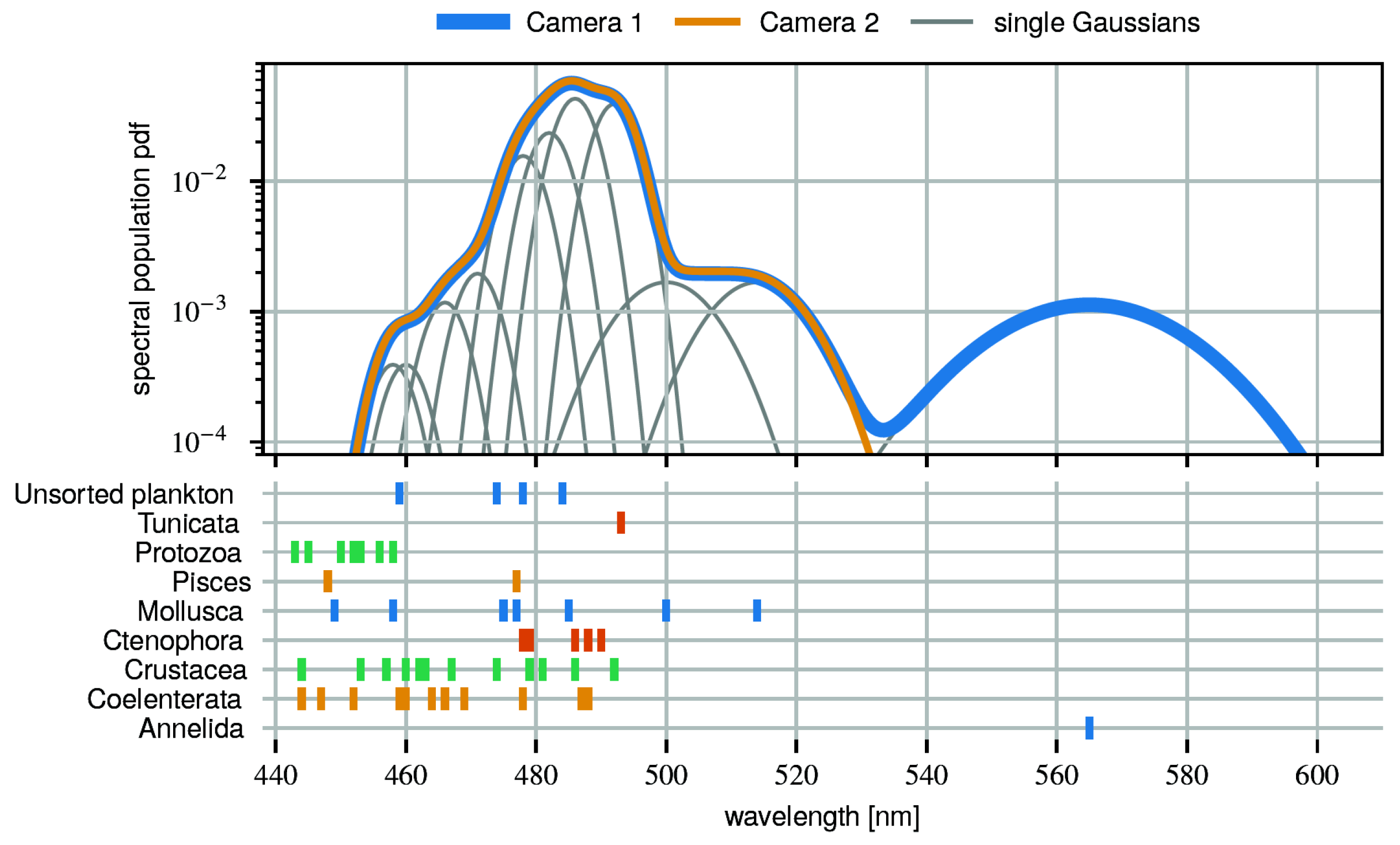Pacific Ocean Neutrino Experiment
Abstract
1. Introduction
2. Experimental Site
3. Detector Hardware and Layout
4. Pathfinder Missions and Results
4.1. Results
4.1.1. Attenuation Length
4.1.2. Salinity and K Content
4.1.3. Background Rates from Bioluminescence
4.1.4. Spectral Population of Bioluminescent Events
5. Towards the First Measurement Line: P-ONE-1
6. Summary and Outlook
Funding
Data Availability Statement
Acknowledgments
Conflicts of Interest
| 1 | Neutrino telescopes provide best sensitivity for up-going events—neutrinos that traverse the Earth. For such events the overwhelming background from atmospheric muons is suppressed. |
References
- Karle, A.; Ahrens, J.; Bahcall, J.; Bai, X. IceCube — the next generation neutrino telescope at the South Pole. Nucl. Phys. B Proc. Suppl. 2003, 118, 388–395. [Google Scholar] [CrossRef]
- Aartsen, M.G.; Abbasi, R.; Abdou, Y.; Ackermann, M. First Observation of PeV-Energy Neutrinos with IceCube. Phys. Rev. Lett. 2013, 111, 021103. [Google Scholar] [CrossRef] [PubMed]
- Aartsen, M.G.; Ackermann, M.; Adams, J.; Aguilar, J.A. Observation of High-Energy Astrophysical Neutrinos in Three Years of IceCube Data. Phys. Rev. Lett. 2014, 113, 101101. [Google Scholar] [CrossRef] [PubMed]
- Padovani, P.; Resconi, E. Are both BL Lacs and pulsar wind nebulae the astrophysical counterparts of IceCube neutrino events? Mon. Not. R. Astron. Soc. 2014, 443, 474–484. [Google Scholar] [CrossRef]
- Aartsen, M.; Ackermann, M.; Adams, J.; Al, A. Neutrino emission from the direction of the blazar TXS 0506+056 prior to the IceCube-170922A alert. Science 2018, 361, 147–151. [Google Scholar]
- Aartsen, M.G.; Ackermann, M.; Adams, J.; Aguilar, J.A.; Ahlers, M. Time-Integrated Neutrino Source Searches with 10 Years of IceCube Data. Phys. Rev. Lett. 2020, 124, 051103. [Google Scholar] [CrossRef]
- Aartsen, M.G.; Abbasi, R.; Ackermann, M.; Adams, J.; Aguilar, J.A.; Ahlers, M. IceCube-Gen2: The window to the extreme Universe. J. Phys. G: Nucl. Part. Phys. 2021, 48, 060501. [Google Scholar] [CrossRef]
- Schumacher, L.J.; Huber, M.; Agostini, M.; Bustamante, M.; Oikonomou, F.; Resconi, E. PLEνM: A global and distributed monitoring system of high-energy astrophysical neutrinos. PoS 2021, 395, 1185. [Google Scholar] [CrossRef]
- Stasielak, J.; Malecki, P.; Naumov, D.; Allakhverdian, V.; Karnakova, A.; Kopański, K.; Noga, W.; on behalf of the Baikal-GVD Collaboration. High-Energy Neutrino Astronomy—Baikal-GVD Neutrino Telescope in Lake Baikal. Symmetry 2021, 13, 377. [Google Scholar] [CrossRef]
- Adrián-Martínez, S.; Ageron, M.; Aharonian, F.; Aiello, S.; Albert, A. The prototype detection unit of the KM3NeT detector. Eur. Phys. J. C 2016, 76, 54. [Google Scholar] [CrossRef]
- Ye, Z.P.; Hu, F.; Tian, W.; Chang, Q.C.; Chang, Y.L. A multi-cubic-kilometre neutrino telescope in the western Pacific Ocean. Nat. Astron. 2023, 7, 1497–1505. [Google Scholar] [CrossRef]
- Agostini, M.; Böhmer, M.; Bosma, J.; Clark, K. The Pacific Ocean Neutrino Experiment. Nat. Astron. 2020, 4, 913–915. [Google Scholar] [CrossRef]
- Schumacher, L.J.; Huber, M.; Bustamante, M. PLEnuM Software Tools. Available online: https://github.com/PLEnuM-group/Plenum (accessed on 1 May 2023).
- Moran, K.; Juniper, S.K.; Bligh, S.; Loock, D.; Kulin, I.; Paulson, M.; Pirenne, B. Canada’s Internet-Connected Ocean. Front. Mar. Sci. 2022, 8, 805134. [Google Scholar] [CrossRef]
- Bailly, N.; Bedard, J.; Bohmer, M.; Bosma, J.; Brussow, D.; Cheng, J.; Clark, K.; Croteau, B.; Danninger, M.; De Leo, F.; et al. Pacific Ocean Neutrino Experiment (P-ONE): Prototype line development. PoS 2021, 444, 1197. [Google Scholar]
- Henningsen, F. Pacific Ocean Neutrino Experiment: Expected performance of the first cluster of strings. PoS 2023, ICRC2023, 1053. [Google Scholar] [CrossRef]
- Boehmer, M.; Bosma, J.; Brussow, D. STRAW (STRings for Absorption length in Water): Pathfinder for a neutrino telescope in the deep Pacific Ocean. J. Instrum. 2019, 14, P02013. [Google Scholar] [CrossRef]
- Rea, I.C.; Holzapfel, K.; Baron, A.; Bailly, N.; Bedard, J.; Bohmer, M.; Bosma, J.; Brussow, D.; Cheng, J.; Clark, K.; et al. P-ONE second pathfinder mission: STRAW-b. In Proceedings of the 37th International Cosmic Ray Conference—PoS (ICRC2021), Berlin, Germany, 12–23 July 2021; Volume 395, p. 1092. [Google Scholar] [CrossRef]
- Bailly, N.; Bedard, J.; Böhmer, M.; Bosma, J.; Brussow, D.; Cheng, J. Two-year optical site characterization for the Pacific Ocean Neutrino Experiment (P-ONE) in the Cascadia Basin. Eur. Phys. J. C 2021, 81, 1071. [Google Scholar] [CrossRef]
- Balkanov, V.; Belolaptikov, I.; Bezrukov, L.; Chensky, A.; Budnev, N.; Danilchenko, I.; Dzhilkibaev, Z.A.; Domogatsky, G.; Doroshenko, A.; Fialkovsky, S.; et al. In situ measurements of optical parameters in Lake Baikal with the help of a Neutrino telescope. Appl. Opt. 1999, 38, 6818–6825. [Google Scholar] [CrossRef]
- Riccobene, G.; Capone, A.; Aiello, S.; Ambriola, M.; Ameli, F.; Amore, I.; Anghinolfi, M.; Anzalone, A.; Avanzini, C.; Barbarino, G.; et al. Deep seawater inherent optical properties in the Southern Ionian Sea. Astropart. Phys. 2007, 27, 1–9. [Google Scholar] [CrossRef]
- Anassontzis, E.G.; Ball, A.E.; Belias, A.; Fotiou, A.; Grammatikakis, G.; Kontoyiannis, H.; Koske, P.; Koutsoukos, S.; Lykoussis, V.; Markopoulos, E.; et al. Light transmission measurements with LAMS in the Mediterranean Sea. Nucl. Instrum. Methods Phys. Res. Sect. A Accel. Spectrometers Detect. Assoc. Equip. 2011, 626–627, S120–S123. [Google Scholar] [CrossRef]
- Smith, R.C.; Baker, K.S. Optical properties of the clearest natural waters (200–800 nm). Appl. Opt. 1981, 20, 177–184. [Google Scholar] [CrossRef] [PubMed]
- Latz, M.; Frank, T.; Case, J. Spectral composition of bioluminescence of epipelagic organisms from the Sargasso Sea. Mar. Biol. 1988, 98, 441–446. [Google Scholar] [CrossRef]
- Holzapfel, K.; Spannfellner, C.; Aghaei, O.; Baron, A.; Bedard, J.; Böhmer, M.; Bosma, J.; Deis, N.; Fink, C.; Fruck, C.; et al. STRAW-b (STRings for Absorption length in Water-b): The second pathfinder mission for the Pacific Ocean Neutrino Experiment. arXiv 2023, arXiv:2310.16714. [Google Scholar] [CrossRef]
- Spannfellner, C. Design of the Pacific Ocean Neutrino Experiment`s First Detector Line. PoS 2023, 444, 1219. [Google Scholar] [CrossRef]
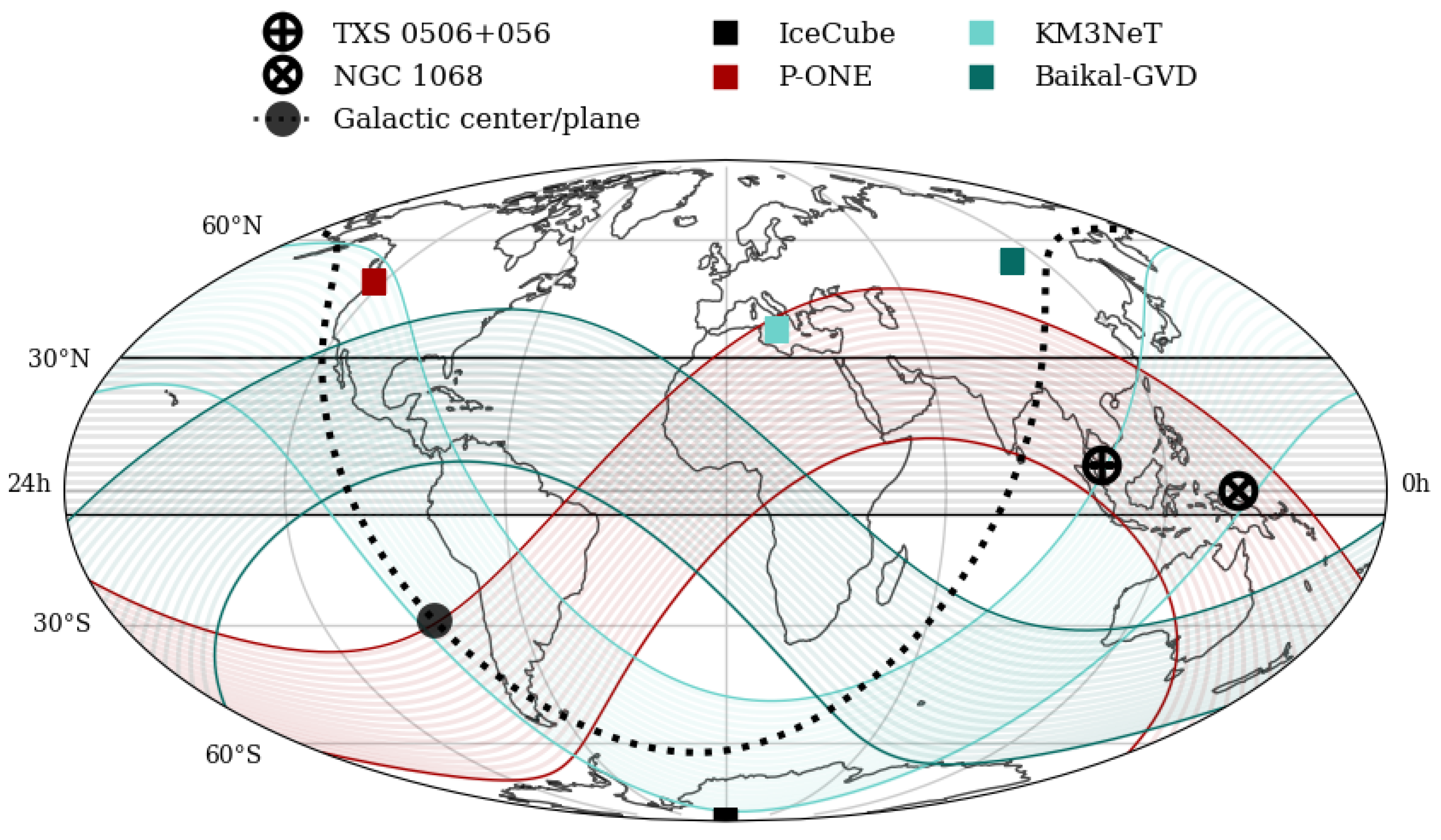
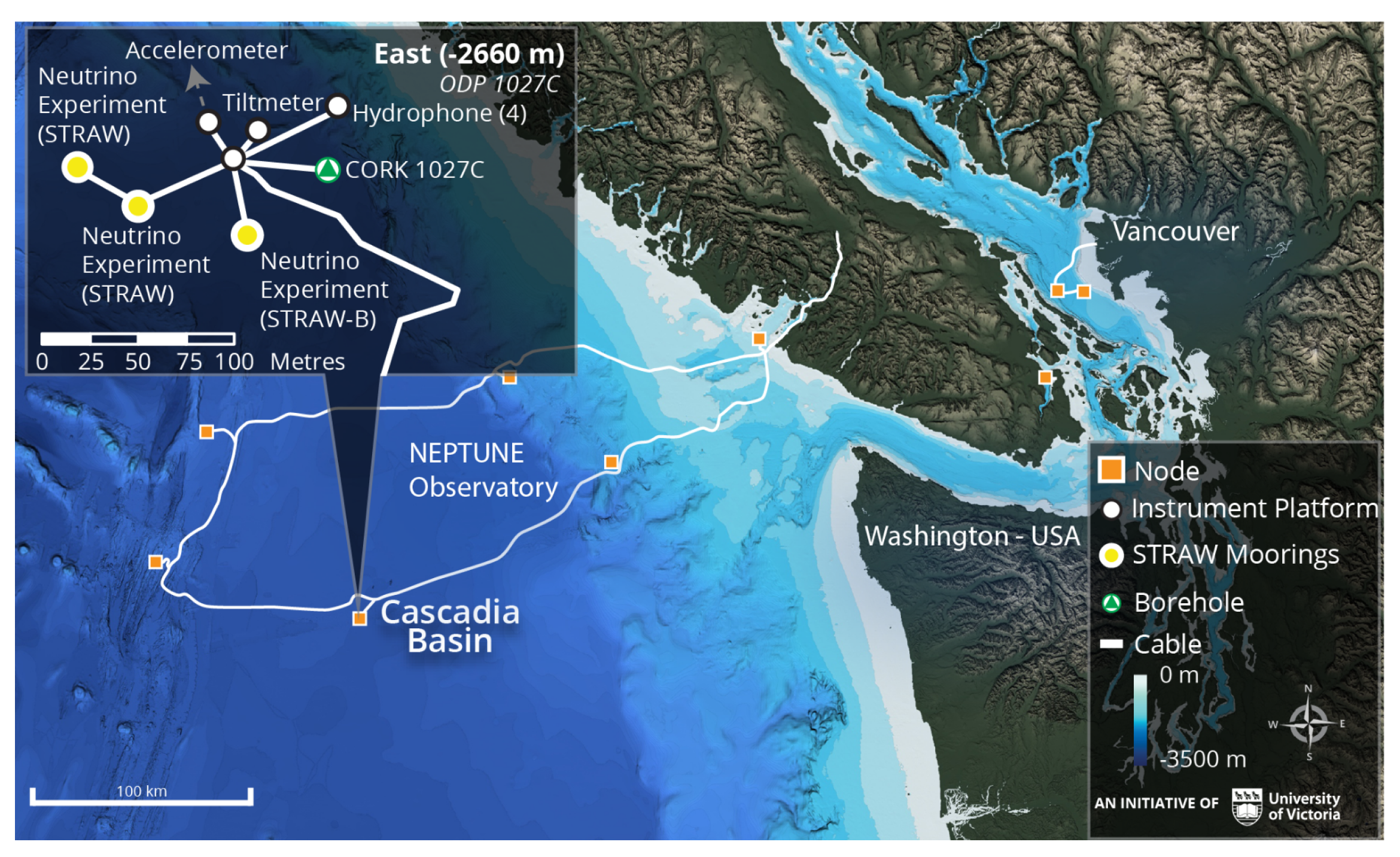
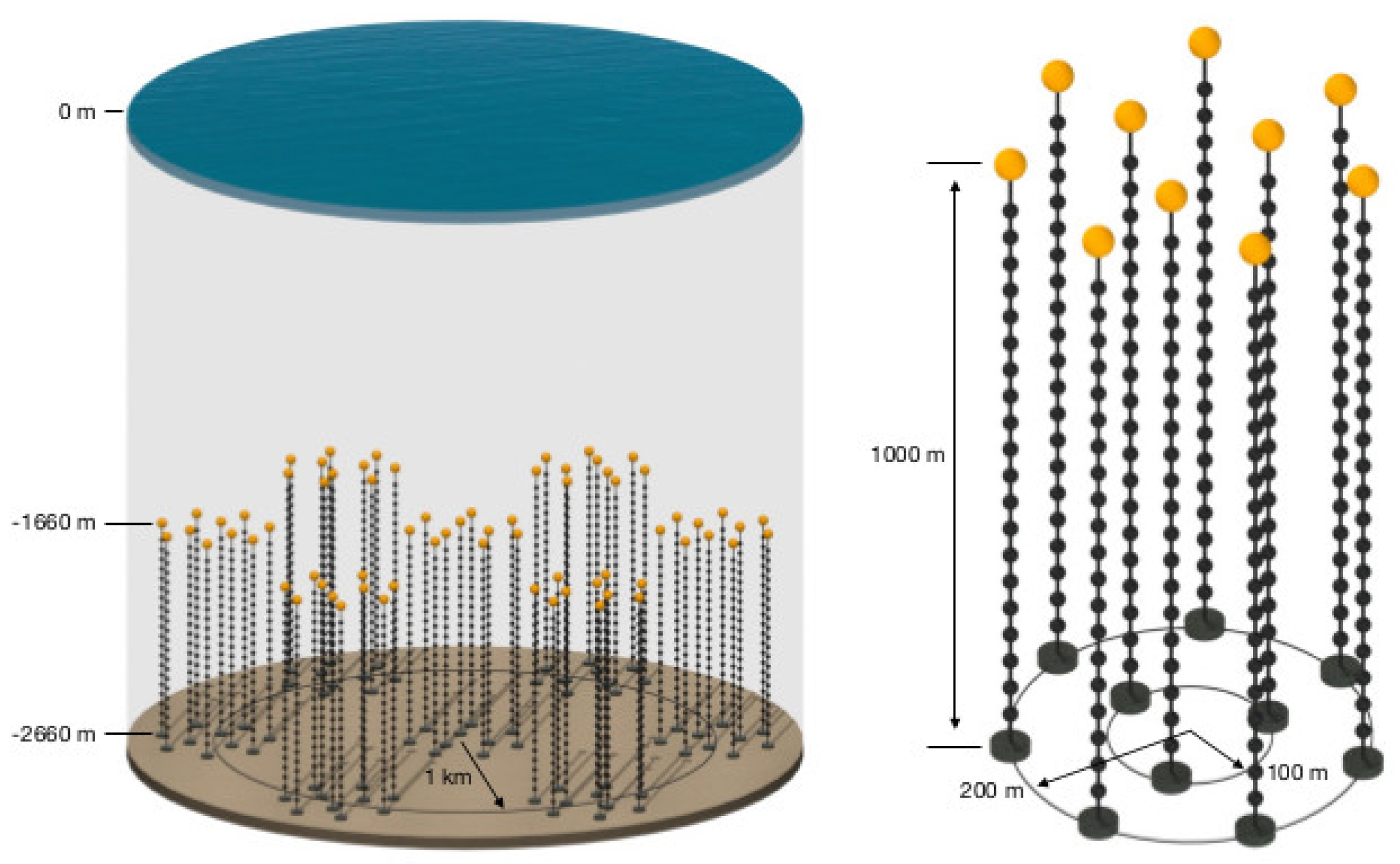

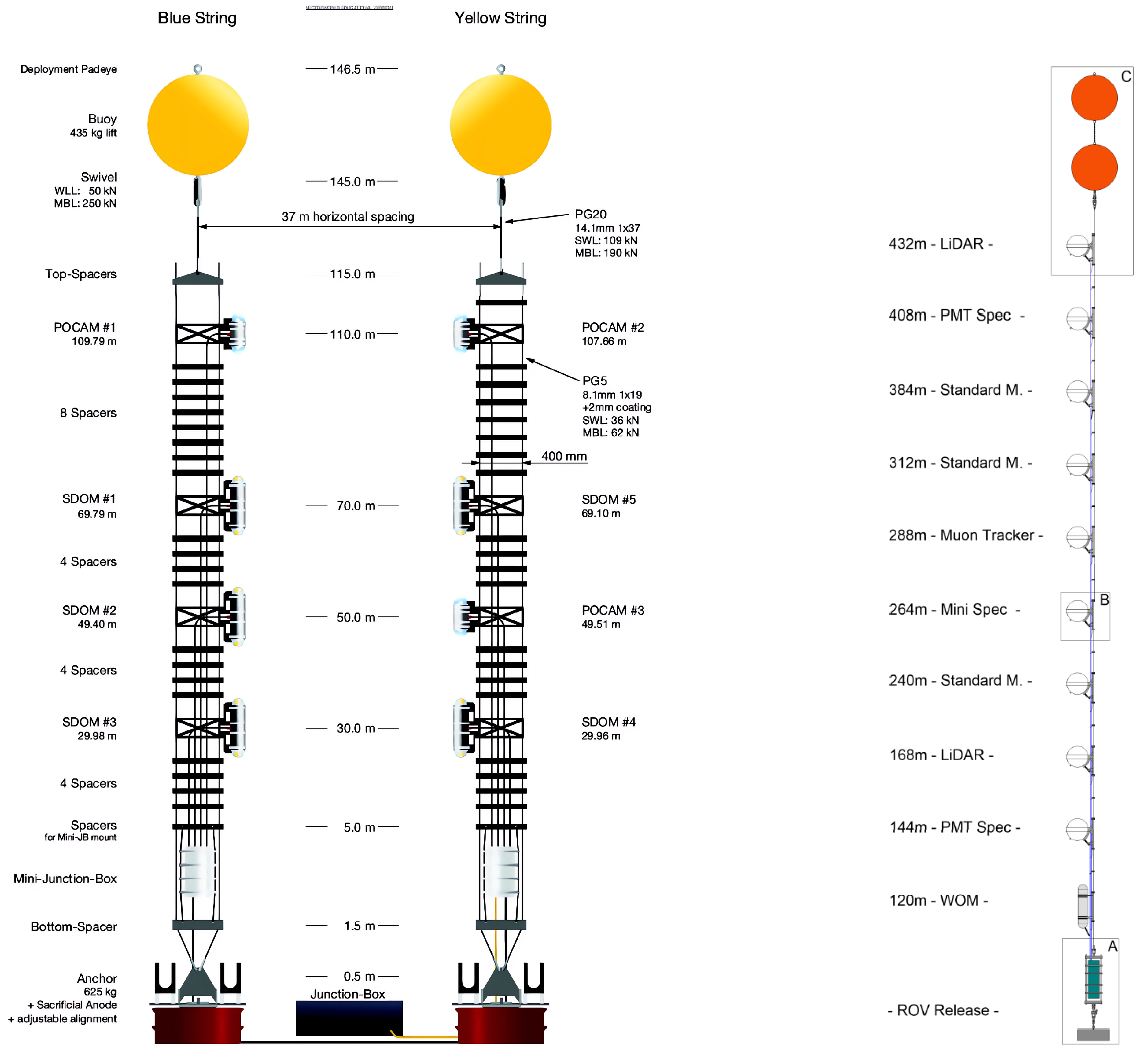
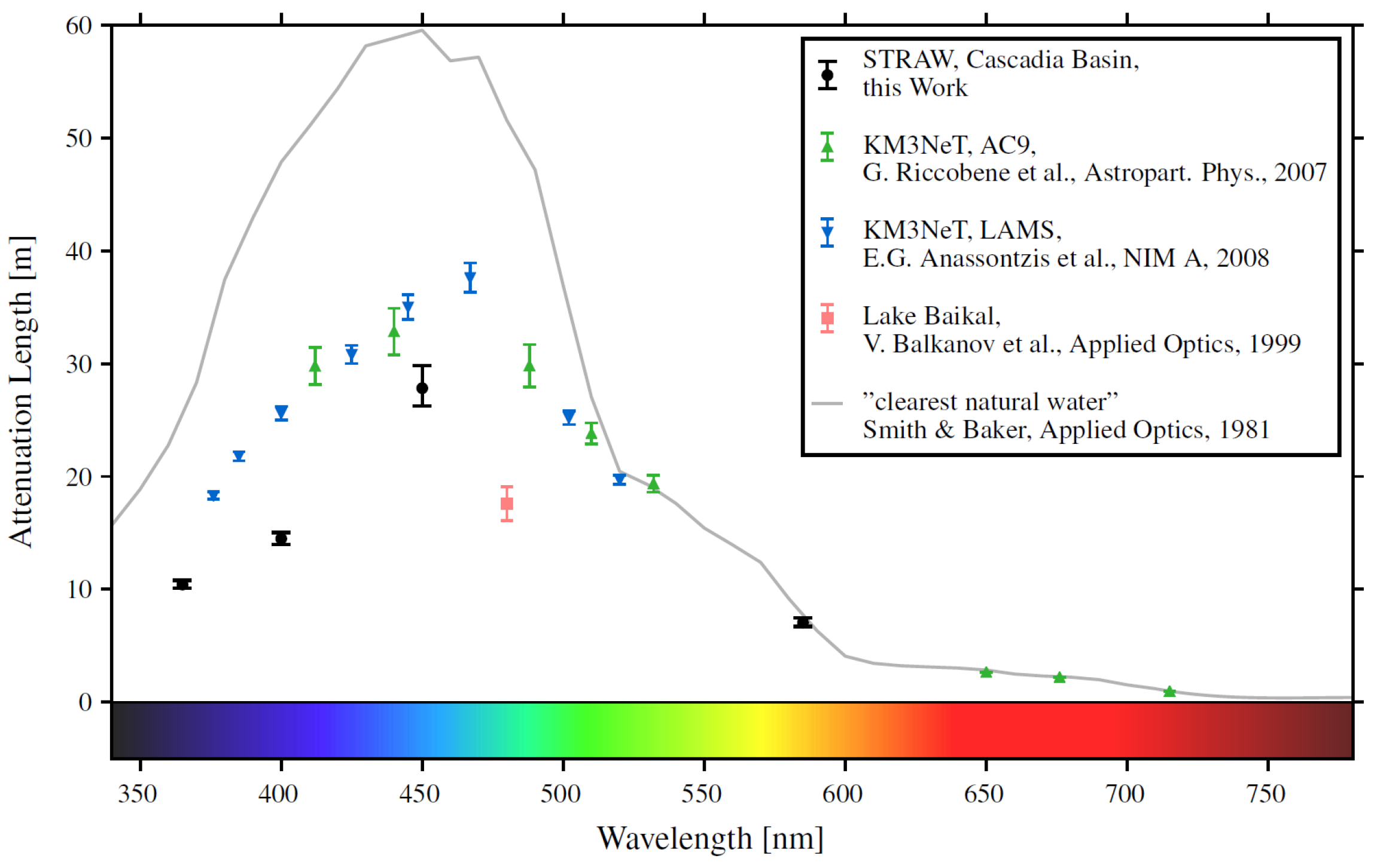

Disclaimer/Publisher’s Note: The statements, opinions and data contained in all publications are solely those of the individual author(s) and contributor(s) and not of MDPI and/or the editor(s). MDPI and/or the editor(s) disclaim responsibility for any injury to people or property resulting from any ideas, methods, instructions or products referred to in the content. |
© 2024 by the author. Licensee MDPI, Basel, Switzerland. This article is an open access article distributed under the terms and conditions of the Creative Commons Attribution (CC BY) license (https://creativecommons.org/licenses/by/4.0/).
Share and Cite
Malecki, P., on behalf of the P-ONE Collaboration. Pacific Ocean Neutrino Experiment. Universe 2024, 10, 53. https://doi.org/10.3390/universe10020053
Malecki P on behalf of the P-ONE Collaboration. Pacific Ocean Neutrino Experiment. Universe. 2024; 10(2):53. https://doi.org/10.3390/universe10020053
Chicago/Turabian StyleMalecki, Paweł on behalf of the P-ONE Collaboration. 2024. "Pacific Ocean Neutrino Experiment" Universe 10, no. 2: 53. https://doi.org/10.3390/universe10020053
APA StyleMalecki, P., on behalf of the P-ONE Collaboration. (2024). Pacific Ocean Neutrino Experiment. Universe, 10(2), 53. https://doi.org/10.3390/universe10020053







